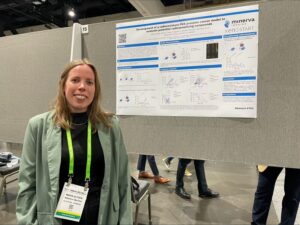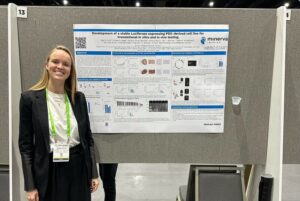AACR 2024: Discover our cutting-edge oncology models
Experience the forefront of oncology research with Minerva Imaging at the AACR Annual Meeting 2024 in San Diego. We presented two posters, each showcasing advancements in our oncology models. Reach out to Fabian Pruissen, Business Developer, if you are interested in receiving a copy of the posters.
Radioresistant PDX prostate cancer model
Current models to study radioresistance in prostate cancer are based on cancer cell lines or cell-line derived xenograft models. These oncology models do not account for the heterogenous and complex biology of the disease. To overcome this issue, we have developed a radioresistant patient-derived xenograft (PDX) prostate cancer model (ST1273/RTR, XenoSTART), that is positive for PSMA. Utilizing this radioresistant model we have investigated the treatment response of Lu177-PSMA-617 in combination with different drug inhibitor classes to evaluate their potential radiosensitizing effect.
Poster details:
- Title: Development of a radioresistant PDX prostate cancer model to evaluate potential radiosensitizing compounds.
- Authors: M. Z. Alfsen, M. Thaysen, N. Nielsen, M. Wick, S. Gnosa, C. H. Nielsen.

Maria presenting the development of a radioresistant PDX prostate cancer model to evaluate potential radiosensitizing compounds at the poster session during the AACR 2024.
Stable luciferase expressing PDX-derived cell line
Cell line-derived xenograft models are widely used preclinically but are often criticized for lacking translational value. A model with higher clinical relevance is the patient-derived xenografts (PDX) model established by implanting patients’ tumor tissue onto immunodeficient mice. To more closely mimic in vivo tumors we have established a PDX-derived cell line (PDXc) and characterized it extensively in a head-to-head comparison to the parental PDX model. Cells were isolated from a subcutaneous glioblastoma (GBM) PDX tumor (ST146), processed into single cells and cultivated in vitro. Tumor-take and growth rate were evaluated against the parental PDX model and common characteristics of the model such as EFGR and Vimentin expression were determined by IHC. We furthermore generated a stable Luciferase expressing PDXc. Tumor growth for subcutaneous and intracranial implanted cells was evaluated using Bioluminescence Imaging, caliper, and MRI.
Poster details:
- Title: Development of a stable luciferase expressing PDX-derived cell line for translational in vitro and in vivo testing.
- Authors: S. Cold, R. N. Bøge, E. Papin, I. T. Michler, L. K. Kristensen, T. B. Engel, A. Kjaer, C. H. Nielsen, S. Gnosa.

Sigrid presenting the development of a stable luciferase expressing PDX-derived cell line for translational in vitro and in vivo testing within oncology at the poster session during the AACR 2024.
PSMA
Minerva proudly co-authored two posters at the AACR 2024 presenting results from studies targeting PSMA. Blue Earth Therapeutics presented the results of an in vitro screen and in vivo proof of concept study, evaluating a synergistic drug combination with 177Lu-rhPSMA-10.1 for prostate cancer. Full Life Technologies presented the anti-tumor activity of 225Ac-FL-020 which is a novel PSMA-targeting radionuclide drug conjugate.
Read more about our oncology services
- Read more about our experience within oncology
- Read more about our Targeted radionuclide therapy services
 Back to news
Back to news